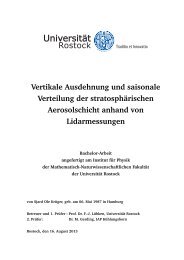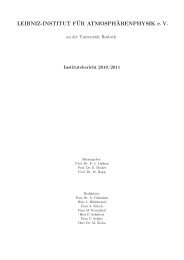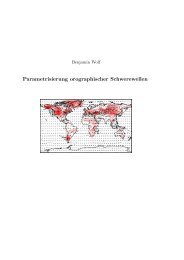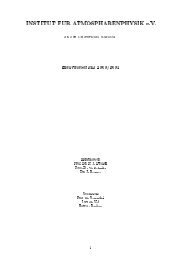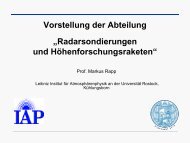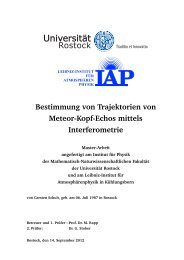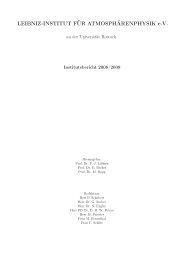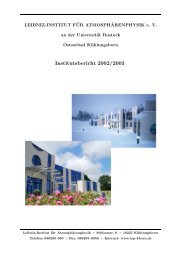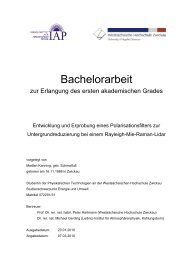Polar mesosphere summer echoes (PMSE): review of ... - HAL
Polar mesosphere summer echoes (PMSE): review of ... - HAL
Polar mesosphere summer echoes (PMSE): review of ... - HAL
You also want an ePaper? Increase the reach of your titles
YUMPU automatically turns print PDFs into web optimized ePapers that Google loves.
M. Rapp and F. J. Lübken: Review <strong>of</strong> <strong>PMSE</strong> 2617<br />
Fig. 22. Measured (symbols) and calculated volume reflectivities<br />
(lines) for different radar Bragg wave numbers (lower abscissa) and<br />
Bragg scale (upper abscissa), respectively. Parameters used in the<br />
calculations for all black lines are given in the black colored insert.<br />
Parameters used in the calculations for all red lines are given in<br />
the red colored insert. The horizontal lines indicate the incoherent<br />
scatter reflectivity (Thomson scatter) for an electron number density<br />
<strong>of</strong> 5000 cm −3 (black) and 500 cm −3 (red), respectively. The two<br />
red symbols mark the observations reported by Röttger (2001).<br />
reduced diffusivity <strong>of</strong> electrons due to the presence <strong>of</strong> a considerable<br />
amount <strong>of</strong> charged aerosol particles seemed to be<br />
sufficient to explain the existence <strong>of</strong> the electron irregularities<br />
at the Bragg scale and subsequently this concept was further<br />
elaborated and applied by several authors (Klostermeyer,<br />
1997, 1999b; Chaxel, 1997; Hill et al., 1999). However,<br />
the observation by Lübken et al. (1993b) (see Sect. 2.4.2)<br />
that soon followed the publication <strong>of</strong> the theory created a<br />
dilemma since they showed that one <strong>of</strong> the crucial requirements<br />
<strong>of</strong> the Cho et al. (1992)-theory, i.e., the presence <strong>of</strong><br />
neutral air turbulence, was not fulfilled. This dilemma triggered<br />
a variety <strong>of</strong> approaches that tried to explain <strong>PMSE</strong> in<br />
the complete absence <strong>of</strong> neutral air turbulence (see Sect. 3.6).<br />
A solution to this dilemma is presented in Sect. 3.5.<br />
3.3.2 Absolute volume reflectivities<br />
Recent observations <strong>of</strong> turbulent energy dissipation rates and<br />
Schmidt-numbers around the polar <strong>summer</strong> mesopause now<br />
also allow for a quantitative comparison <strong>of</strong> observed and<br />
computed radar volume reflectivities based on the above described<br />
theory (Lübken et al., 1994, 1998, 2002). In Fig. 22<br />
we compare the measured absolute reflectivities stated in Table<br />
1 with calculations <strong>of</strong> the volume reflectivity based on a<br />
Schmidt-number dependent turbulence model (Driscoll and<br />
Kennedy, 1985) (for details on the calculation <strong>of</strong> the volume<br />
reflectivity based on the Driscoll and Kennedy-model<br />
see Giebeler, 1995). Figure 22 shows that with reasonable<br />
values for the Schmidt-number (Lübken et al., 1998), the<br />
turbulent energy dissipation rate (Lübken et al., 2002), the<br />
Fig. 23. Decay times <strong>of</strong> a Gaussian electron perturbation (with a<br />
width = 67 cm) as a function <strong>of</strong> =|Z A |N A /Ne for the case <strong>of</strong><br />
positive ions and singly negatively charged aerosol particles with a<br />
radius <strong>of</strong> 10 nm and different values <strong>of</strong> T e /T n . This figure is reproduced<br />
from Rapp and Lübken (2000), copyright by the American<br />
Geophysical Union.<br />
electron number density N e and the electron irregularity dissipation<br />
rate ɛ e (Giebeler, 1995) the observations at 50 MHz,<br />
224 MHz and 500 MHz can be readily explained (thick black<br />
line). It is also interesting to note that using the same parameters<br />
but ɛ=2.5 W/kg (which is the largest value that has so far<br />
been reported Lübken et al., 2002) also allows to explain the<br />
observed reflectivity at 933 MHz (thick dashed line). Note<br />
further that the product N 2 e · ɛ e is ∝ N e , where N e an absolute<br />
small scale fluctuation <strong>of</strong> the electron number density<br />
(Driscoll and Kennedy, 1985). Hence, N 2 e · ɛ e characterizes<br />
the absolute magnitude <strong>of</strong> the electron number density fluctuations<br />
due to turbulence and determines the absolute level<br />
<strong>of</strong> the calculated reflectivity. With this information in mind,<br />
we also see that the considerably lower values reported by<br />
Röttger (2001) can be directly explained in the scope <strong>of</strong> the<br />
Cho et al. (1992)-theory (red dotted line). In summary, the<br />
Cho et al. (1992)-theory can explain <strong>PMSE</strong> observations at<br />
all radar frequencies provided that indeed neutral air turbulence<br />
is present.<br />
3.3.3 Evidence for electron diffusivity controlling <strong>PMSE</strong><br />
As described in Sect. 2.6 the observations <strong>of</strong> an active modulation<br />
<strong>of</strong> <strong>PMSE</strong> through RF-heating <strong>of</strong> the ambient electrons<br />
have opened a new experimental window for the study<br />
<strong>of</strong> <strong>PMSE</strong>. Rapp and Lübken (2000) interpreted the observations<br />
by Chilson et al. (2000) in the scope <strong>of</strong> the electron<br />
temperature dependence <strong>of</strong> the electron diffusion in the<br />
vicinity <strong>of</strong> charged aerosol particles and found that an electron<br />
temperature rise indeed explains the observed features.<br />
Figure 23 shows calculated decay times for idealized disturbances<br />
<strong>of</strong> Gaussian shape in the electron number density in<br />
www.atmos-chem-phys.org/acp/4/2601/ Atmos. Chem. Phys., 4, 2601–2633, 2004



